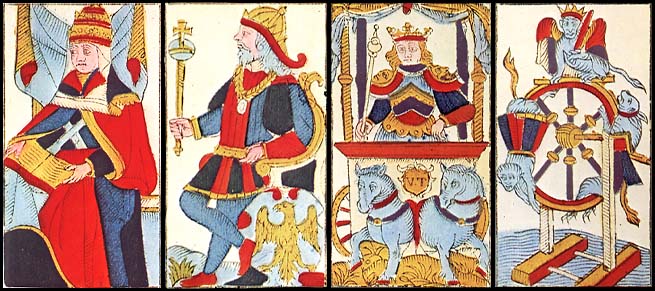Your Legal Resource
A Lexicon Theory Of Tarot Origin
A Lexicon Theory of Tarot Origin
by Mark Filipas
The Tarot first appeared in northern Italy, during the birth of Europe´┐Żs cultural revolution. Those original decks were probably designed between 1420 and 1440, although the earliest extant cards date from later in the 1400s.
This Italian game eventually made its way throughout Europe, and countries such as France, Spain, and Germany soon became major cardmaking centers themselves. This spread and popularity resulted in a variety of different Tarot decks. But because there are few surviving early decks, and because the cards themselves were neither named nor numbered until several decades after their invention, it is uncertain which pattern represents the original sequence of allegories.
The Marseilles pattern´┐Żso named because it characterizes the decks traditionally produced in Marseilles, France´┐Żis only one of several early variations. Nonetheless, it represents one candidate for the earliest sequence of trumps, and many of its images echo the earliest designs from the 1400s. Its pattern can be traced back at least to the 1660s with the Tarot by Jean Noblet, and to 1672 with the Tarot of Francois Chosson. Other well-known examples of this pattern are the 1748 Tarot by Grimaud and the 1760 Tarot by Nicolas Conver.
Since these creators left no manual for their decks, we must look for explanatory clues in the details of the designs themselves. We can also look at the cultural context in which these cards first appeared. Yet while the designs show a variety of influences´┐Żsuch as social hierarchy, the Virtues, Biblical and classical allusions, astrology, and perhaps even alchemy´┐Żthese do not adequately explain why the Tarot´┐Żs early designers settled upon this specific set of designs, or why they arranged the designs in this particular sequence.
Did the Hebrew alphabet influence the early Tarot´┐Żs design?
This question has been hotly debated now for more than a century. At one end of the spectrum are those who argue that the letters were fundamentally associated with the trumps from the beginning. At the other end are those who argue that there is no evidence to conclude any link between the early Tarot and the Hebrew alphabet.
This site introduces new research showing a demonstrable correspondence between the Hebrew letters and the Marseilles Tarot. That correspondence lies within the medieval Hebrew lexicon, which contains an alphabetical sequence of words corresponding to the 22 allegorical subjects. Each trump, in effect, illustrates one Hebrew letter in much the same way as a child´┐Żs English primer echoes ´┐ŻA is for apple´┐Ż and ´┐ŻB is for a boy´┐Ż. Not only can the allegorical subjects be found in alphabetical sequence, but virtually every item on each trump can be found with the same initial letter, suggesting the Tarot of Marseilles to be a ´┐Żvisual abecedarium´┐Ż of the Hebrew alphabet.
These correspondences can only fully be found in the lexicon as it existed at the time of the early Tarot, such as is represented by Jastrow´┐Żs Dictionary of the Targumim, Talmud Balbi, Yerushalmi, and Midrashic Literature, and Grossman´┐Żs Compendious Hebrew´┐ŻEnglish Dictionary. These findings are further restricted to an analysis of only two patterns, the Marseilles Tarot (as typified by decks such as the Conver) and the Tarocchino Milanese (designed by Carlo Dellarocca).
This theory follows the current historical consensus that the trumps were first created in Northern Italy during the first half of the 15th century and that its designs incorporated allegories that were popular at that time. It does not posit that the Tarot was designed with kabbalistic intentions, nor does it suggest that the creators of such designs would have had to have been Jewish. What this theory does show is that a singular correspondence exists between trumps and lexicon; that the many alphabetic pursuits existing at the time and place of the early designs must be examined as potential influences; that both the Marseilles and Dellarocca patterns may have been intentionally designed as a Hebrew alphabetical sequence. These and other issues will be examined more closely in the following pages.
Continue to Tarot and the Hebrew Alphabet
the primary linguistic parallels
